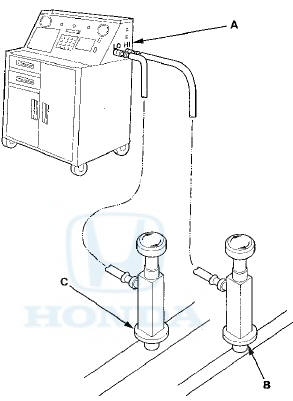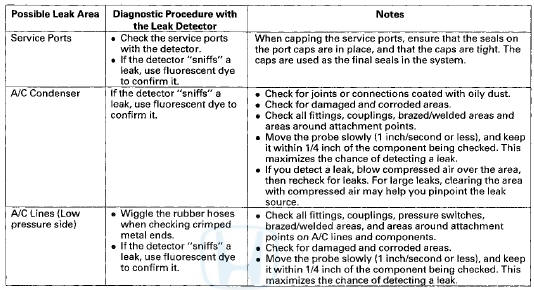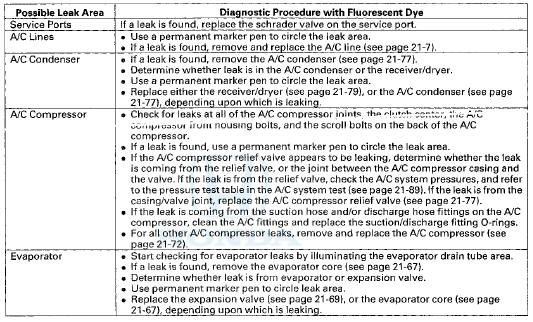 Honda Accord: Refrigerant Leak Check
Honda Accord: Refrigerant Leak Check
Special Tools Required
• Leak Detector YGK-H-10PM*
• Leak Detector HLD-100*
• Leak Detector TIFZX-1*
• OPTIMAX Jr. A/C Leak Detection Kit TRP124893*
*Available through the Honda Tool and Equipment Program; call 888-424-6857
• Air conditioning refrigerant or lubricant vapor can irritate your eyes, nose, or throat.
• Be careful when connecting service equipment.
• Do not breathe refrigerant or vapor.
• Do not operate the leak detector near flammable vapors. Its sensor operates at high temperatures, and could ignite the vapors, resulting in personal injury and/or damage to the equipment.
NOTE: • If an accidental system discharge occurs, ventilate the work area before resuming service.
• Additional health and safety information may be obtained from the refrigerant and lubricant manufacturers.
• Check the system for leaks using an R-134a refrigerant leak detector with an accuracy of 14 g (0.5 oz) per year or better.
Leak Detector Usage Tips (Refer to the Operator's Manual for complete operating instructions)
• Position the vehicle in a wind-free work area. This will aid in detecting small leaks.
• When using the leak detector for the first time, allow it to warm up for 2 minutes with the probe in a clean atmosphere. This lets the temperature sensor in the detector stabilize.
• The calibration check should be done in the "Search 2" mode. Once that is done, the other check modes do not need calibrating.
• When leak checking through the HVAC module drain hose, avoid drawing water into the probe. Water can damage the internal pump and sensor.
• Avoid creasing the flexible probe extension. Creases can restrict air flow and give false readings.
• Because the detector recalibrates itself for ambient gases, it may be necessary to move the detector away from the leak to clear the sensor. Once the sensor has cleared, recheck the suspected leak.
• When removing the clear probe tip, be careful not to lose the flow ball.
• R-134a is heavier than air; always check below and to the sides of all potential leak sources.
• Halogen leak detectors are sensitive to chemicals: windshield washing solutions, solvents/cleaners, and some vehicle adhesives. Keep these chemicals out of the area when doing leak detection.
Fluorescent Dye Usage Tips
• Use only Tracer-Stick single dose fluorescent dye .
capsules from TracerlineВ®. Other dyes contain solvents that may contaminate the refrigerant oil, leading to component failure.
• Adding excessive amounts of dye can damage the compressor.
• PAG oil is water soluble, so condensation on the evaporator core or the refrigerant lines may wash the PAG oil and fluorescent dye away from the actual leak.
Condensation may also carry dye through the HVAC module drain.
• After checking and repairing leaks, thoroughly clean any residual dye from the areas where leaks were found. Use GLO-AWAY dye cleaner, from Tracerline®, and hot water to remove the dye (follow the instructions on the bottle). Residual dye stains can cause misdiagnosis of any future A/C system leaks.
• If any refrigerant dye contacts an exterior paint surface, remove it by doing this: - Carefully wash the affected surfaces to remove any dirt, and to prevent paint scratching.
- Mix water and isopropyl alcohol in a 50/50 mixture.
Soak a soft 100 percent cotton towel with the water/alcohol mixture, and place the cloth on the affected areas to remove the dye.
- After removing the dye with the water/alcohol-soaked cloth, carefully wash the affected areas, and check that there is no remaining dye.
1. Connect an R-134a refrigerant recovery/recy cling/charging station (A) to the high-pressure service port (B) and the low-pressure service port (C), as shown, following the equipment manufacturer's instructions.

2. Recover refrigerant from the A/C system (see page 21-80), and evacuate the system {see page 21-80). If the system achieves a vacuum of approximately - 9 3 . 3 kPa { - 7 0 0 mmHg, -27.6 inHg) in 15 minutes, and holds the vacuum for 15 minutes, then the system does not have a leak at this time. If the system cannot achieve or hold a vacuum, continue the refrigerant leak check.
3. Open the high pressure valve to charge the system to the specified capacity. Select the appropriate units of measure for your refrigerant charging station.
Refrigerant Capacity:
400 to 450 g
0.40 to 0.45 kg
0.9 to 1.0 lbs
14.1 to 15.9 oz
4. With the engine OFF, use a halogen leak detector first to detect the leak source. Follow a continuous path in order to ensure that you will not miss any possible leaks. Test the following areas of the system for leaks:

5. Close the quick coupler valves, then disconnect the quick couplers from the vehicle service ports.
6. Attach the universal connect set, from the Optimax Jr. Leak Detection Kit, to the service valve fitting. Close the control valve (the black knob on the connect set).
7. Attach the charging station low pressure hose quick coupler to the service valve fitting, and open the quick coupler valve. Evacuate the connect set using the charging station vacuum pump, then close the quick coupler valve.
8. Detach the universal connect set, and install a Tracer-StickВ® dye capsule between the connect set and the service valve fitting (see the manufacturer's instructions for more detail).
9. Attach the quick coupler on the universal connect set to the low pressure service port on the vehicle. Open the charging station low pressure hose quick coupler valve, but do not open the control valve.
10. Start the engine, and set the A/C system to maximum cooling. Open the control valve to let refrigerant and the dye enter the A/C system through the low pressure service port. Close the control valve when the Tracer-Stick" dye capsule is empty.
11. Run the engine and A/C system for 15 minutes to thoroughly circulate the dye. Then shut the engine off, and inspect the following areas of the system for leaks: NOTE: • Check for leaks in a dark work area, and use the UV light and the special glasses from the leak check kit. Other UV lights may not work well with the Tracer-Stick* dye.
• Small leaks may take up to 1 week of vehicle operation (with normal A/C use) to become visible.

 System Charging
System Charging
• Air conditioning refrigerant or lubricant vapor can
irritate your eyes, nose, or throat.
• Be careful when connecting service equipment.
• Do not breathe refrigerant or vapor.
...
 A/C System Noise Check
A/C System Noise Check
• Air conditioning refrigerant or lubricant vapor can
irritate your eyes, nose, o r throat.
• Be careful when connecting service equipment.
• Do not breathe refrigerant or vapor. ...
See also:
Component Location Index
Front
4-door Rear
...
Driver's Power Seat Motor Test
1. Remove the d r i v e r ' s seat (see page 20-194).
2. Remove t h e p o w e r seat adjustment switch knobs a nd
t h e recline cover f r om t h e seat.
• 4-door (see page 20-234)
• ...
Outside Air Temperature Sensor
Replacement
1. Lift the tab (A) to release the lock, then remove the
outside air temperature sensor (B) from the front
bumper beam. Disconnect the 2P connector (C) from
the outside air temperature sensor.
2 ...
